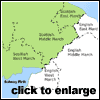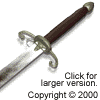
|
An Introduction to the Border Reivers by Stuart William Bird (BA (Hons) History) Webmaster http://www.borderreivers.org.uk
It is a land that under normal circumstances would produce a hard resilient people. From the thirteenth through to the early seventeenth century, this geography may have hardened the people, but the politics of the two countries honed this toughness to a fine edge. By the late sixteenth century this edge had in every sense become dangerously sharp. History has christened this the country of the Border Reiver, a term peculiar to the area.
The people who participated in reiving did have other trades, such as farming, or working as a soldier, but because of the poor economic conditions, caused by the constant fighting, they were often unable to support themselves. The practice of splitting the farmland between the sons of a farmer resulted in the land becoming too small to provide enough for the family to live off, which also contributed to the conditions.
Reiving was to an extent, a seasonal occurrence, lasting from autumn to spring, of which the worst time was from Michalaelmas (September 29) to Martinmas (November 11). The ground was dry and the cattle and horses were strong enough for the drive, and by February oats were too expensive and the nights to short for significant raids. The reiver was not just an accomplished thief, but also an excellent light horseman and would be armed with plate armour, mail, or more common to the Borders a ‘jak of plaite’. This was usually sleeveless and constructed of quilted cloth, twill or linen and had small overlapping iron plates stitched inside. Their heads were protected by a range of steel helmets and they would be armed with a sword, a lance (8 to 12 foot long), various knives, bows and crossbows.
The problem that was to lead to the Border reivers can roughly be dated back to Edward I's attempt to conquer Scotland in 1296. Though it should be noted that this marked a dramatic decline within the state of the Border, some 38 years earlier sufficient disintegration had already taken place for the two countries to send representatives to meet and agree upon international Border laws. This saw the beginning of some 300 years of sporadic warfare, often resulting in a war of attrition, the bloody and cruel fighting was to leave the Borders deeply scarred, and the people suffered severely.
|
Thursday, December 26th, 2019
Attention visitors: Tartans.com is back. Please note that this is a snapshot of the site as it existed nearly 20 years ago and you may encounter broken links; we are still combing through the site and correcting those as we find them. Please also note that some sections are currently not functional, primarily the discussion forums/clan chat boards.
|
** HOME - First Time Visitors - Glossary - - Contact Us ** Awards | Bibliography | Clan Calendar | Clan Chat | Clan Finder | History | Famous Scots | Genealogy | Great Hall of the Clans | Links | News and Features | Scots on the Net | Search | Site Map The Gathering of the Clans
Copyright 1995- Tartans.com - All Rights Reserved. |



